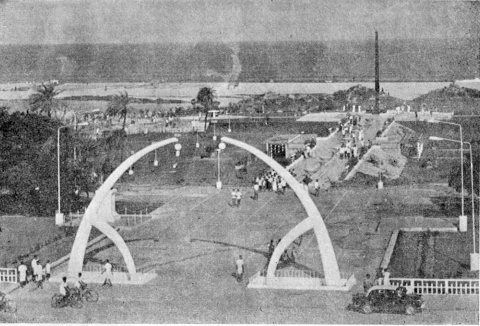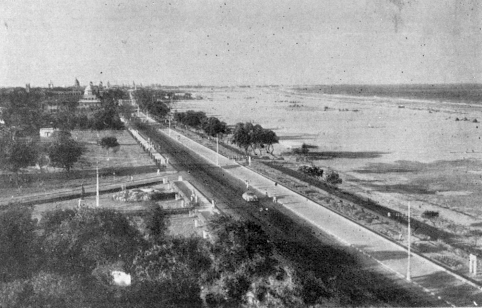Registered with the Registrar of Newspapers for India under R.N.I 53640/91
Vol. XXXII No. 21, February 16-28, 2023
Lost Landmarks of Chennai
-- by Sriram V
Statues and Memorials on the Marina
At a time when the proposed pen memorial on the beach is the subject of much debate, it is worthwhile to dwell briefly on the history of statues and memorials on the Marina. The first memorial of any kind to come up on the beach was that of Queen Victoria, unveiled in 1887, on the occasion of her completing fifty years as monarch. It was funded by Gode Narayana Gajapati Rao, the Zamindar of Vishakhapatnam, sculpted by Joseph Boehm, and unveiled by the then Governor, Lord Connemara. It still stands outside the University Senate House. The next to come up on the beach was a memorial to a police officer. At the intersection of South Beach and Edward Elliots Roads, which means it was where the roundabout with a clock from Simpson’s is now standing, was a fountain erected in memory of Col. Charles Arkoll Porteous, Inspector General of Police, Madras, who died in 1895. There is a Porteous Road in Perambur as well. The fountain, a gift to the city by the “Upper Subordinates of the Police Department”, was a column of dressed Pallavaram granite bearing a basin. On this was a block of dressed granite “on which is fixed a figure of an Indian juggler, in bronze. The water is caused to flow up through the figure and is discharged through two cups held in the juggler’s hands. The column stands in a cistern built of granite.” This has since vanished.
 A view of the Anna Square shortly after completion in 1975. Picture courtesy: Greater Chennai Corporation archives.
A view of the Anna Square shortly after completion in 1975. Picture courtesy: Greater Chennai Corporation archives.The first Indian to get a statue on the beach was V. Krishnaswami Iyer. After a dizzying rise at the Bar, he became judge and then member of the Governor’s Executive Council, only to pass away at the relatively young age of 47 on December 28, 1911. During that short life, he set up several enduring institutions, all documented well in Madras Musings. On his passing, it was felt that a statue would be the best memorial for him. Funds poured in, of which Rs. 5,000 came from the Suguna Vilasa Sabha, the premier amateur dramatic society of Madras, of which he was president.
If Krishnaswami Iyer had many admirers, he did not lack detractors either. The Hindu was one, for its proprietor Kasturiranga Iyengar had been cold-shouldered when he was a struggling lawyer. The Swadesamitran had never reconciled to Iyer accepting the post of a judge, its former sub-editor Subramania Bharati in particular pouring scorn on him for joining the British-dominated judiciary. When a public meeting was held on January 16, 1912, at the Banqueting (now Rajaji) Hall to consider the matter of a suitable memorial for Krishnaswami Iyer, the opposition nearly managed to sway the tide of public opinion. Their chief argument was that he had disliked statues, being the chief opponent when the statue for Sir T. Muthuswami Iyer was proposed at the High Court. He considered the very idea to be against Hindu dharma. But his opponents had not contended with Sir S. Subramania Iyer, then a Justice of the High Court and a mentor to Iyer. His emotional speech carried the day and swung opinion in favour of the statue. The next day, The Hindu expressed distress that a man of Sir Subramania Iyer’s stature had displayed emotion in public.
 A Marina without statues dating to 1965. Picture courtesy: Greater Chennai Corporation archives.
A Marina without statues dating to 1965. Picture courtesy: Greater Chennai Corporation archives.The statue, the first beach-fronted one for an Indian and sculpted by Francis Derwent Wood, came up in due course outside Senate House. It was a singularly appropriate location, for Krishnaswami Iyer had been a member of the University Senate and had also saved the beach from a proposal to build a railway line on it. The statue’s pedestal records that it was put up by public subscription, a statement that carefully hides the differences of opinion therein.
In 1915, on the passing of Gopal Krishna Gokhale, the Madras chapter of the Servants of India Society of which he was founder voted for a statue in his memory. This was erected outside the University and unveiled by Justice Sir Abdur Rahim in 1927. Then, in 1935, a statue for Sir Subramania Iyer, sculpted by M.S. Nagappa, came up next to that of V. Krishnaswami Iyer. Many years later, a statue for Dr. Sir A. Lakshmanaswami Mudaliar would be put up outside the University building, commemorating the Vice Chancellor with the longest tenure. This was unveiled by Sir Archibald Nye in 1964. By then, other statues had come up, all of them facing the beach. These included Annie Besant, Dr. U. Ve Swaminatha Iyer, and Swami Vivekananda. Besant’s statue, unveiled by Sir C.P. Ramaswami Iyer in 1945, was largely due to the efforts of her ardent follower Arcot Ranganatha Mudaliar. Swaminatha Iyer likewise had a champion in his disciple Ki Va Jagannathan. The Vivekananda statue was unveiled by the then President of India, Sarvepalli Radhakrishnan in July 1964.
The first statue to come up on the sea front was that of Mahatma Gandhi, sculpted by Debi Prasad Roy Chowdhury and unveiled by Pt Jawaharlal Nehru in 1956. Shortly thereafter, the Triumph of Labour, by the same sculptor, was unveiled further down the road. These then were the monuments by the beach until the Second World Tamil Conference which was held in 1968 under the aegis of the newly-elected DMK Government led by C.N. Annadurai. That was the occasion for a number of statues, all of scholars who had contributed to the growth of Tamil, to be erected along the sea side. These were executed by noteworthy sculptors such as S. Dhanapal and Mani Nagappa. Along with flesh-and-blood subjects, we also had the literary character Kannagi.
Anna passed away in 1969 and a part of the beachfront, originally earmarked for the construction of the city’s lighthouse, was taken over for a memorial to the leader. He was buried there and a black granite monument fronted by other structures would come up for him. Many years later, Anna’s trusted aide and former matinee idol and Chief Minister, M.G. Ramachandran would be buried alongside and get a memorial for himself. The memorial square containing Anna and MGR would later open up again to receive J. Jayalalithaa and M. Karunanidhi. She has a memorial that is, according to the Government, shaped like a phoenix, while he will soon get a pen-shaped memorial in the sea. The Anna Square precinct encompasses two of the statues to Tamil savants erected in 1968 – Ilango and Bishop Caldwell, both of which are now more or less hidden from public view.
In the 1990s, statues of K. Kamaraj and Netaji Subhas Chandra Bose would be added to the beachfront. The former, depicts the leader flanked by a young boy and girl, in recognition of his pioneering the noon-meal scheme. The latter is plainly disappointing – it is not even in proportion to the other statues on the beach. Not so much in the public eye is a statue for Swami Sivananda, at the corner of the University buildings, facing Napier Bridge. Also forgotten is the fact that just opposite where this statue stands, and by the Cooum, was a memorial to Lord Ampthill, Governor of Madras from 1900 to 1906. Nobody knows what happened to it and we don’t seem to have any photographs either.
A statue of Sivaji Ganesan was put up facing south, just ahead of the Simpsons clock. This has since been removed and installed in Adyar. Perhaps the most recent among all the statues is that of J. Jayalalithaa, standing inside the Lady Willingdon campus and facing the sea. Add to the above lot a plaque commemorating the freedom meetings that were held by the beach, some other monuments of vague logic in the name of beautification and then a grotto of sorts with snakes, birds and much else, and you have what may be termed a full hand. Not so if you believe our politicians who would like to add a lot more statues and memorials, if only they had their way.


Pingback: History of the Statues Along The Marina - Madras Heritage and Carnatic Music